Birds have been a popular subject for centuries, inspiring countless artists and writers throughout history. In particular, they have played a prominent role in music, with many songs featuring various bird species’ sounds, movements, and behaviors.
From classical compositions to popular songs and everything in between, birds have captivated the imagination of musicians and listeners alike.
Whether it’s the enchanting melodies of a lark, the majestic flight of an eagle, or the haunting call of a nightingale, birds add beauty, mystery, and symbolism to the world of music.
In this article, we will explore the role of birds in songs, their symbolism, and their impact on the musical landscape.
28 Birds In Songs
Birds have long captured the imagination of humans, inspiring art, literature, and music across cultures and centuries. Their ethereal songs, vibrant plumage, and graceful flight have been a wellspring of creativity for artists of all kinds.
Music stands out as a particularly enchanting medium among the various art forms that pay homage to these feathered creatures.
Here are 28 Birds In Songs.
1. Thrush
Thrushes are small to medium-sized birds belonging to the Turdidae family and found all over the world. They live on or near the ground and feed on insects, other invertebrates, and fruit.
Their feathers range from greyish browns to deep blues with ted wings that help them blend into their natural habitats such as forests, woodlands, and shrubs,s.
Thrushes sing distinctive songs during spring mating season; many species also perform complex flight displays for courtship rituals.
These birds may be solitary creatures but can often be seen foraging together in groups or pairs when searching for food sources like worms, snails, or berries.
A healthy thrush population indicates a balanced environment since they require clean water sources and plenty of vegetation cover – making them critical indicators of ecosystem health worldwide.
Scientific classification:
| Kingdom | Animalia |
| Phylum | Chordata |
| Class | Aves |
| Order | Passeriformes |
| Suborder | Passeri |
| Family | Turdidae Rafinesque, 1815 |
Also Featured In: Common Birds in India, Most Common Romanian Birds
2. Northern Cardinal
The Northern Cardinal is a beautiful bird, easily identified by its bright red plumage. It can be found in the eastern United States from Maine to Minnesota and south through Mexico and Belize.
Along with its striking coloration, it has a distinctive crest on its head and sharp black facial markings around the eyes.
Despite their small size (measuring 7-9 inches), they are very vocal birds – males sing persistently throughout springtime to attract mates or proclaim their territory.
They typically feed on insects, seeds, and fruits but enjoy suet at backyard bird feeders.
The female is less brightly colored than her mate but still stands out among other songbirds due to her warm brownish-red feathers.
Cardinals pair for life, so you may often see them together in your garden or neighborhood park.
Scientific classification:
| Kingdom | Animalia |
| Phylum | Chordata |
| Class | Aves |
| Order | Passeriformes |
| Family | Cardinalidae |
| Genus | Cardinalis |
| Species | C. cardinalis |
Also Featured In: Most Common United States Birds, Birds for Your Home Garden
3. American Robin

The American robin is a migratory bird belonging to the valid thrush genus and Turdidae family.
It was named after its European counterpart due to the similar reddish-orange breast they possess; however, they are not closely related.
This species can be seen through most of North America during winter months and in parts of Mexico and Central America, where it also breeds.
They have plump bodies with gray upperparts and white underparts that vary from yellow on their throats down to orange toward their bellies.
Robins feed on fruits such as berries or insects like worms,, making them an essential part of ecosystems by helping disperse seeds naturally throughout these areas.
Scientific classification:
| Kingdom | Animalia |
| Phylum | Chordata |
| Class | Aves |
| Order | Passeriformes |
| Family | Turdidae |
| Genus | Turdus |
| Species | T. migratorius |
Also Featured In Most Common Winter Birds, Flocks Birds around Us
4. Northern Mockingbird
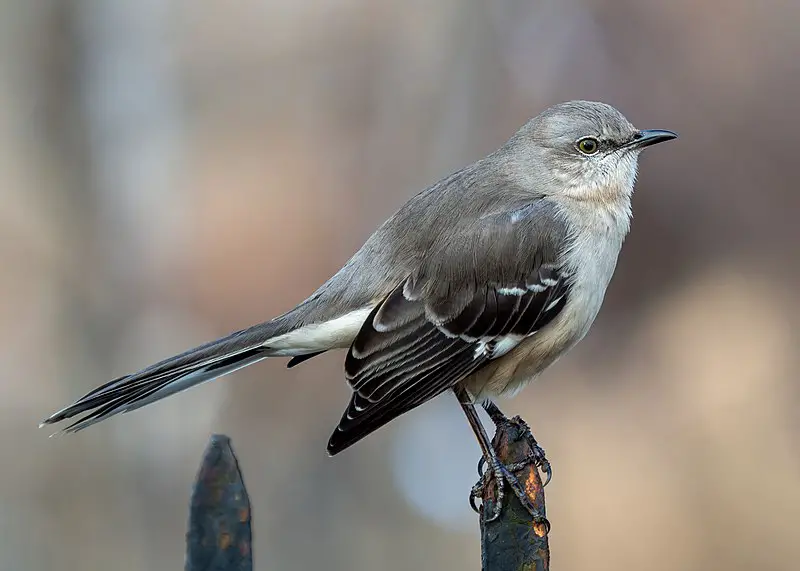
The northern mockingbird is a common fixture in North American skies. It has greyish-brown upperparts and a paler underside with white wing patches, and its distinctive long tail makes it easy to spot.
This adaptable bird can often be seen singing from the tops of trees or fences, though it rarely strays into Europe.
Carl Linnaeus first described the species in his 1758 Systema Naturae as Turdus polyglottos – aptly named for their remarkable ability to mimic other birds’ songs.
Northern mockingbirds typically live on insects, fruits, berries, and seeds but will also happily scavenge food scraps left out by humans.
This beloved avian contributes to our environment with its beautiful song and striking plumage.
Scientific classification:
| Kingdom | Animalia |
| Phylum | Chordata |
| Class | Aves |
| Order | Passeriformes |
| Family | Mimidae |
| Genus | Mimus |
| Species | M. polyglottos |
Also Featured In: Birds Live Near San Diego, Birds that Live in San Francisco Bay Area
5. American Goldfinch
The American goldfinch is a small North American bird in the finch family. Males are vibrant yellow with black wings and tails, while females are duller in coloration.
It migrates from mid-Alberta to North Carolina during the breeding season, south of Canada–United States border to Mexico for its wintering grounds.
The only finch that undergoes complete molt every year displays sexual dichromatism, where males have brighter colors than their female counterparts.
They feed mainly on seeds but also eat insects such as aphids and caterpillars when raising young; they often occur near thistles or other plants that produce viable seed heads.
Their call consists of various chirps and trills, making them quite conspicuous.
Scientific classification:
| Kingdom | Animalia |
| Phylum | Chordata |
| Class | Aves |
| Order | Passeriformes |
| Family | Fringillidae |
| Subfamily | Carduelinae |
| Genus | Spinus |
| Species | S. tristis |
Also Featured In: Birds That Live in Colorado, Blue Birds You’ll Found Around Us
6. Songbirds
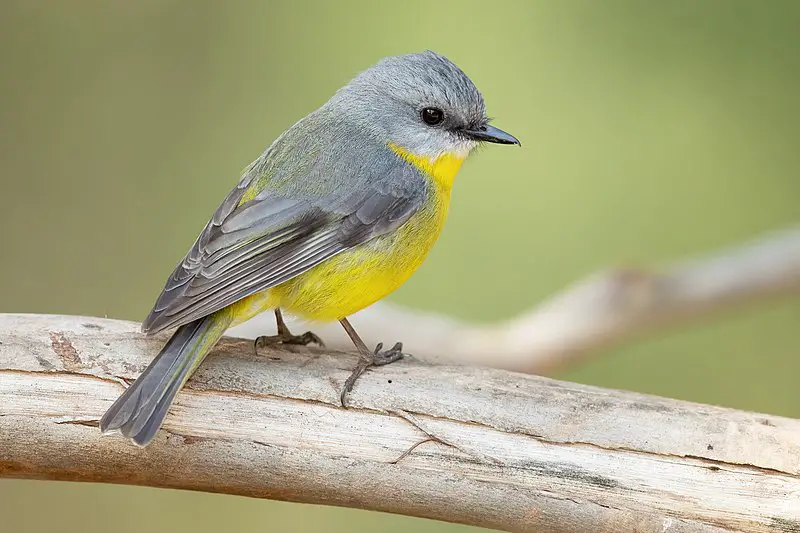
Songbirds are a special suborder of perching birds found all over the world. These beautiful creatures have intricate vocal organs that allow them to produce elaborate bird songs, making them stand out from other species.
With around 5,000 different types of songbirds, they come in various sizes and colors, with complex feathers adding to their beauty.
Songbirds play an essential role in ecosystems as they help disperse seeds by eating fruit and insects that act as pollination agents.
Their presence also attracts more biodiversity into areas where these delicate animals live, creating vibrant habitats full of life.
Scientific classification:
| Kingdom | Animalia |
| Phylum | Chordata |
| Class | Aves |
| Order | Passeriformes |
| Clade | Eupasseres |
| Suborder | Passeri Linnaeus, 1758 |
Also Featured In: Famous Paintings Birds, Common Birds in the Cities
7. Western Meadowlark
The western meadowlark is a medium-sized icterid bird native to North America. It has a distinct yellow breast with black and white patches, making it easy to spot in open grasslands.
Its diet consists primarily of bugs but also includes seeds and berries. The western meadowlark’s call is unique – its sound is flute-like or watery, differentiating it from the similar eastern meadowlark species.
When the nesting season arrives, they build their nests on the ground near shrubs or low trees in areas like fields and pastures.
This beautiful songbird adds life to our open lands with its melodious tunes.
Scientific classification:
| Kingdom | Animalia |
| Phylum | Chordata |
| Class | Aves |
| Order | Passeriformes |
| Family | Icteridae |
| Genus | Sturnella |
| Species | S. neglecta |
Also Featured In: Birds that Live in the Grasslands, Common Birds in Saskatchewan
8. Black-Capped Chickadee
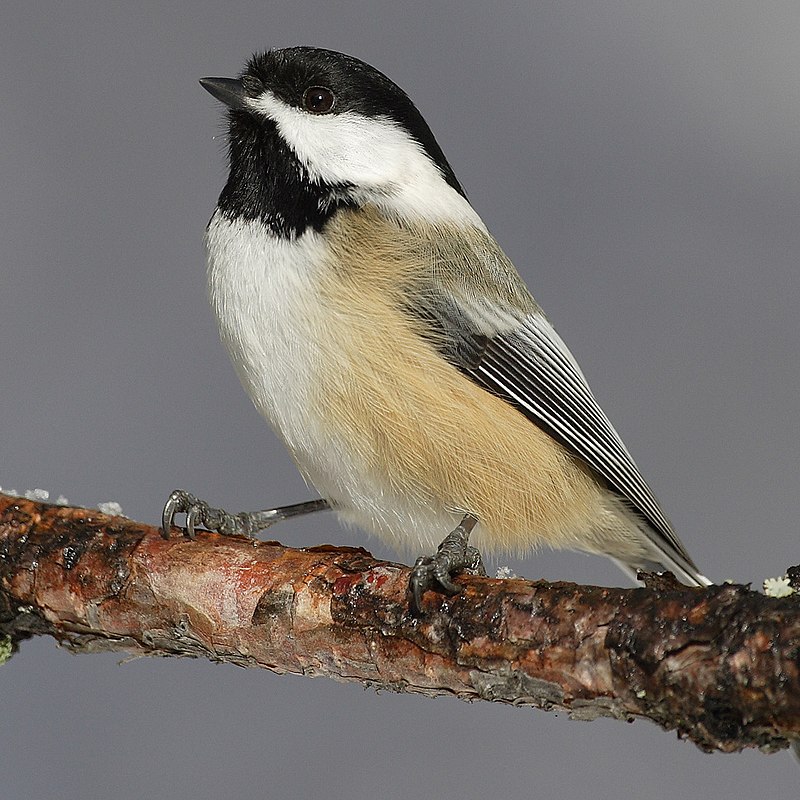
The black-capped chickadee is a small, cheerful songbird in deciduous and mixed forests across North America. It has an iconic black cap, white cheeks, gray back, and wings with whitish bars.
The underparts are usually light-colored or greyish-brown. This species is well adapted to cold winters as it can reduce its body temperature by up to 8°C while roosting at night; this helps save energy during the year’s colder months.
It feeds mainly on insects but eats seeds, fruits, and suet from bird feeders when available.
Black-capped chickadees are popular birds among backyard visitors due to their friendly nature – they often establish lifelong partnerships with one another for breeding purposes.
Furthermore, they have been designated as state birds of Massachusetts and Maine in the USA, plus New Brunswick in Canada – a testament to how beloved these little avian friends are.
Scientific classification:
| Kingdom | Animalia |
| Phylum | Chordata |
| Class | Aves |
| Order | Passeriformes |
| Family | Paridae |
| Genus | Poecile |
| Species | P. atricapillus |
Also Featured In: Autumn Birds You Should Know, British Columbian Birds
9. Wrens
Wrens are a family of small brown passerine birds found mainly in the Americas. They are considered one of the most abundant bird species, with 88 known varieties divided into 19 genera.
The Eurasian wren is the only type inhabiting Europe and other parts of the Old World, commonly referred to simply as “wren.”
This species has been given its name due to similar-looking unrelated birds living elsewhere, such as New Zealand wrasses.
Wrens have tiny bodies with thin bills and long tails, which they often hold upright for hours while singing their loud, cheery songs from treetops or low shrubs.
Their diet consists mainly of insects but can also include fruits and seeds depending on availability in their habitat range.
Scientific classification:
| Kingdom | Animalia |
| Phylum | Chordata |
| Class | Aves |
| Order | Passeriformes |
| Superfamily | Certhioidea |
| Family | Troglodytidae Swainson, 1832 |
Also Featured In: Common Denmark Birds, Most Common Scotland Birds
10. Eastern Bluebird
The Eastern bluebird is a small migratory thrush found in North America’s open woodlands, farms, and orchards.
The male has bright-blue breeding plumage, which makes it easily recognizable by birders.
It produces melodic songs such as Jeew, chair-wi, and Chili WEEW Widow.
This widespread species was declared the state bird of Missouri back in 1927 due to its beauty and charm.
In addition to being beautiful, these birds are also beneficial for farmers because they eat insects like grasshoppers and beetles, which damage crops.
They nest in cavities, so providing nesting boxes helps them thrive even more.
With their vibrant colors, sweet melodies, and helpful nature, it’s easy to see why the Eastern Bluebird is beloved worldwide.
Scientific classification:
| Kingdom | Animalia |
| Phylum | Chordata |
| Class | Aves |
| Order | Passeriformes |
| Family | Turdidae |
| Genus | Sialia |
| Species | S. sialis |
Also Featured In: House Birds You’ll Love to Pet, Birds that Migrate through Illinois in the Spring
11. Baltimore Oriole
The Baltimore Oriole is a small, blackbird-like bird in eastern North America. It’s named for the resemblance of its male colors to those on Lord Baltimore’s coat-of-arms from the 17th century.
These birds migrate and breed during springtime and are standard in their habitats.
Studies have shown that this species interbreeds with western Bullock’s orioles, classifying both as a single species – Icterus galbula.
The males typically have orange feathers along the chest, back, wings, and tail, while females display tan or yellowish shades instead of bright orange-like males.
Both sexes share white wing bars and dark brown eyes, making them easily distinguishable from other birds.
They can often be seen flitting around trees, feeding off nectar buds or insects such as grasshoppers & caterpillars they catch while flying around.
Scientific classification:
| Kingdom | Animalia |
| Phylum | Chordata |
| Class | Aves |
| Order | Passeriformes |
| Family | Icteridae |
| Genus | Icterus |
| Species | I. galbula |
Also Featured In: Birds that Calls in the Morning, Common Birds in Alberta
12. Brown Thrasher
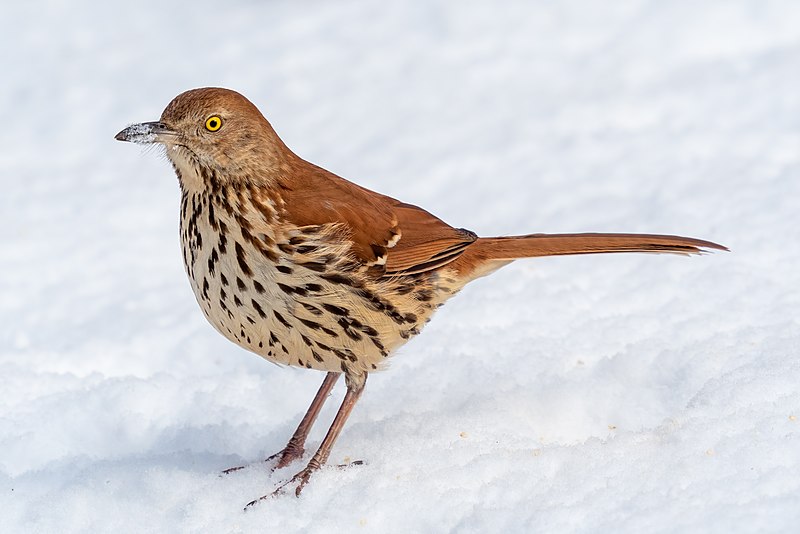
The brown thrasher is a member of the Mimidae family, along with catbirds and mockingbirds. It is found throughout much of North America in the eastern and central United States and southern and central Canada.
The only place it does not inhabit is west of the Rockies or Central Texas.
This bird can be identified by its reddish-brown back feathers, white underbelly, and long tail that often drags behind it when walking on the ground hunting for food like insects, fruits, or berries.
Its loud song consists of over 2000 different notes.
Brown Thrashers are known to build nests close to human activity, which makes them easily accessible for observation, making them a popular backyard species among many birdwatchers.
Scientific classification:
| Kingdom | Animalia |
| Phylum | Chordata |
| Class | Aves |
| Order | Passeriformes |
| Family | Mimidae |
| Genus | Toxostoma |
| Species | T. rufum |
Also Featured In: Birds that Live in Mississippi, Brown Birds that Live in West Virginia
13. Common Loon
The Common Loon is a beautiful bird found in North America. It has a large black head and neck, with a greenish to purple sheen that stands out against its dark grey upperparts.
The underparts are white except for some black on the undertail cover and vent.
During the non-breeding season, adults have brown plumage instead of the bright shades they show during the breeding season.
They also exhibit unique behaviors, such as diving underwater to catch fish or swimming along lakeshores while calling loudly, which is how they got their name “great northern diver.”
With their stunning colors and interesting behavior, it’s no wonder why these birds make up an iconic part of many landscapes across North America.
Scientific classification:
| Kingdom | Animalia |
| Phylum | Chordata |
| Class | Aves |
| Order | Gaviiformes |
| Family | Gaviidae |
| Genus | Gavia |
| Species | G. immer |
Also Featured In: Water Birds Live around Us, Shetland Islands Birds You Should Know
14. Blue Jay
The Blue Jay is a beautiful bird in the eastern and central United States and Newfoundland, Canada.
They have an unmistakable blue plumage with white markings on their heads and wings.
These birds are highly adaptable to habitats ranging from deciduous forests to urban areas.
As part of the Corvidae family, they are known for being intelligent problem solvers who often use tools or mimic vocalizations of other species, like hawks, when defending their territories.
Their diet consists mainly of insects, seeds, and nuts but can also include small vertebrates such as frogs or lizards if food resources become scarce.
Overall, these birds provide much-needed color to our environment while playing essential roles in maintaining healthy ecosystems through pollination services and seed dispersal activities.
Scientific classification:
| Kingdom | Animalia |
| Phylum | Chordata |
| Class | Aves |
| Order | Passeriformes |
| Family | Corvidae |
| Genus | Cyanocitta |
| Species | C. cristata |
Also Featured In: Most Common Nature Birds, Birds in Iowa Spring
15. Wood Thrush
The Wood Thrush is a beautiful bird native to North America, closely related to the American Robin.
It has mottled brown and white upperparts with a spotted breast, buffy sides and flanks, and reddish-brown tail feathers.
This medium-sized thrush prefers wooded areas where it can find its favorite food – insects such as beetles, caterpillars, and spiders.
The male’s song is one of the most recognizable sounds in nature, an ethereal mix of flute-like whistles that often echo through forests on warm summer nights.
The Wood Thrush holds special status as the official bird of Washington D.C., making it even more beloved amongst residents who take pride in seeing this exquisite species up close.
Scientific classification:
| Kingdom | Animalia |
| Phylum | Chordata |
| Class | Aves |
| Order | Passeriformes |
| Family | Turdidae |
| Genus | Hylocichla Baird, 1864 |
| Species | H. mustelina |
Also Featured In: Brown Tennessee Birds, Brown Birds of Florida
16. New World Warblers
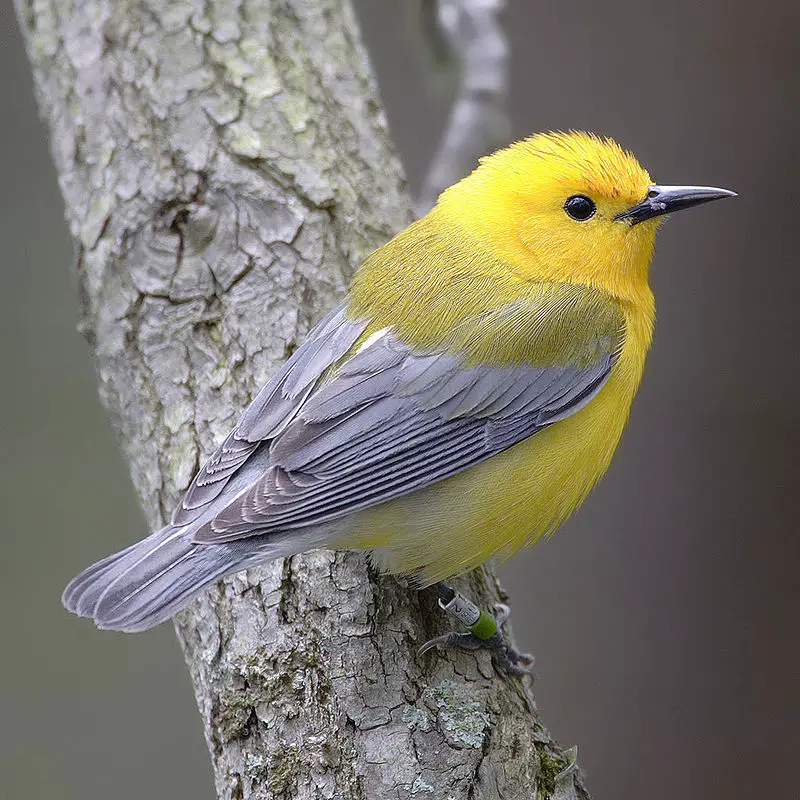
New World warblers are an incredibly diverse family of small birds found only in the Americas. They range in size from tiny hummingbirds to large thrushes and come in various vibrant colors.
All have thin bills made for eating insects, which form their primary diet. Most species live predominantly arboreal lives, meaning they spend most of their time among trees or bushes searching for food.
However, some members, such as ovenbirds and waterthrushes, prefer more terrestrial habitats like forest floors where they can scavenge for bugs on the ground instead.
Warblers provide a great source of entertainment with their beautiful songs, often filling up woodlands during mornings and evenings throughout springtime.
Scientific classification:
| Kingdom | Animalia |
| Phylum | Chordata |
| Class | Aves |
| Order | Passeriformes |
| Superfamily | Emberizoidea |
| Family | Parulidae Wetmore et al., 1947 |
Also Featured In: Birds that Live in Faroe Islands, Common Species of Birds
17. House Sparrow
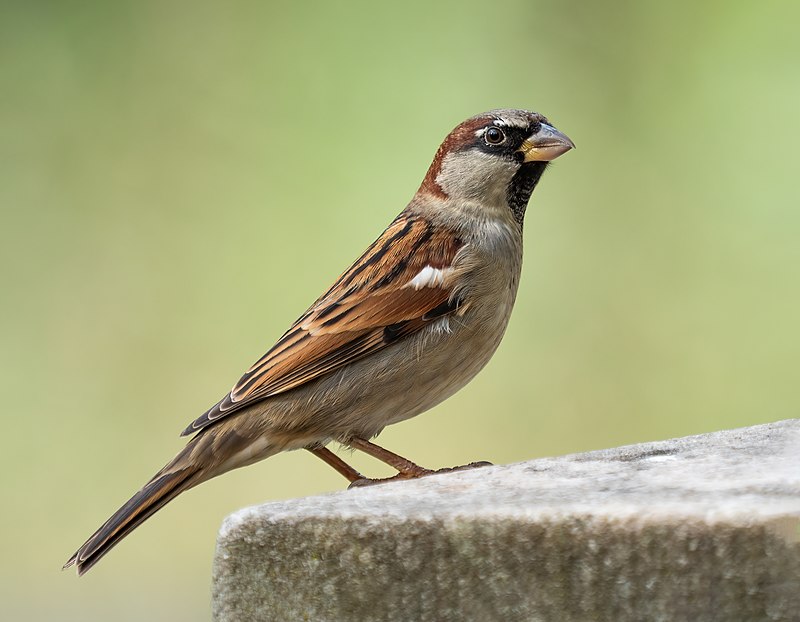
The house sparrow is a small bird of the Passeridae family. It has an average length of 16 cm and weighs 24-39.5 gm.
Females have dull brown and grey plumage, whereas males are brighter, with black, white, and brown markings on their wings and back feathers.
This species is one among 25 different kinds in its genus Passer. These birds are found worldwide, mainly near human dwellings where they feed off food scraps from garbage bins, gardens, etc.
They also make nests close to houses, making them even more visible to people nearby.
House sparrows can be seen hopping around yards for food during daytime hours but usually hide in colonies at night.
Scientific classification:
| Kingdom | Animalia |
| Phylum | Chordata |
| Class | Aves |
| Order | Passeriformes |
| Family | Passeridae |
| Genus | Passer |
| Species | P. domesticus |
Also Featured In: Asian Birds, European Birds
18. House Finch

The House Finch is a finch species native to western North America and has been introduced in the eastern half of the continent and Hawaii.
It’s an average-sized finch with adults measuring 12.5 – 15 cm (5 – 6 inches) long and a wingspan between 20 – 25 cm (8 – 10 inches).
The upperparts are brown, while its underparts range from pale grayish white to yellow depending on subspecies.
Its face is streaked or spotted with reddish coloration; males typically have brighter plumage than females due to sexual dimorphism.
They’re mostly found near human habitations such as farms and gardens, where they feed on grains, fruits, insects, etc., making them very popular among birders who want something colorful for their backyard.
Scientific classification:
| Kingdom | Animalia |
| Phylum | Chordata |
| Class | Aves |
| Order | Passeriformes |
| Family | Fringillidae |
| Subfamily | Carduelinae |
| Genus | Haemorhous |
| Species | H. mexicanus |
Also Featured In: Common Birds That Live in Las Vegas, Birds That Live Around Seattle
19. Mourning Dove
The Mourning Dove is a breathtakingly beautiful bird. It has stunning gray and brown feathers with white-tipped wings, giving it an elegant appearance. Its long tail also adds to its graceful look in flight.
A symbol of peace and serenity, they are abundant across North America and can be found in gardens or open fields throughout the year.
As well as being popular game birds for hunters, they feed on grains such as wheat and millet, providing essential food sources for wildlife species, including foxes, coyotes, skunks, and raccoons.
These doves have a distinctive cooing sound that can often echo through woodlands during summer evenings, making them one of nature’s greatest treasures.
Scientific classification:
| Kingdom | Animalia |
| Phylum | Chordata |
| Class | Aves |
| Order | Columbiformes |
| Family | Columbidae |
| Genus | Zenaida |
| Species | Z. macroura |
Also Featured In: Small Kentucky Birds, Brown Birds that are Found in Mississippi
20. Tufted Titmouse
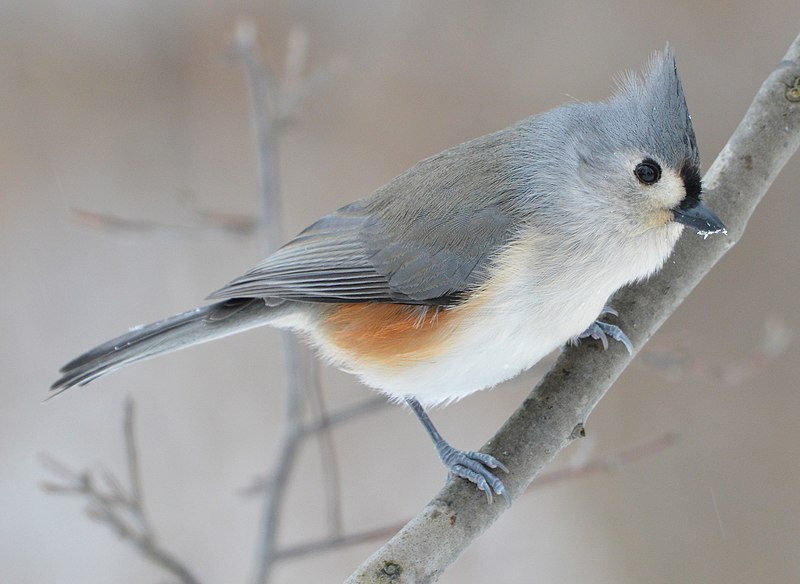
The Tufted Titmouse is a small, cheerful songbird found in North America. It’s part of the tit and chickadee family (Paridae).
It has distinctive white feathers around its eyes, grey-brown wings, and upper body, with a pale tan underside.
Its most notable feature is the black crest on top of its head, which gives it a curious look. The male also sports a pinkish breast, which can be seen.
When singing from high perches during the spring months. This bird loves to eat sunflower seeds or suet at backyard feeders and insects in summertime.
You may even see them poking into crevices and bark, looking for food.
They are exceptionally social birds, too, being often spotted in mixed flocks alongside other species, such as nuthatches and woodpeckers, all year round.
Scientific classification:
| Kingdom | Animalia |
| Phylum | Chordata |
| Class | Aves |
| Order | Passeriformes |
| Family | Paridae |
| Genus | Baeolophus |
| Species | B. bicolor |
Also Featured In Common Birds of Houston, Small Birds that Live in Washington D.C.
21. Carolina Wren
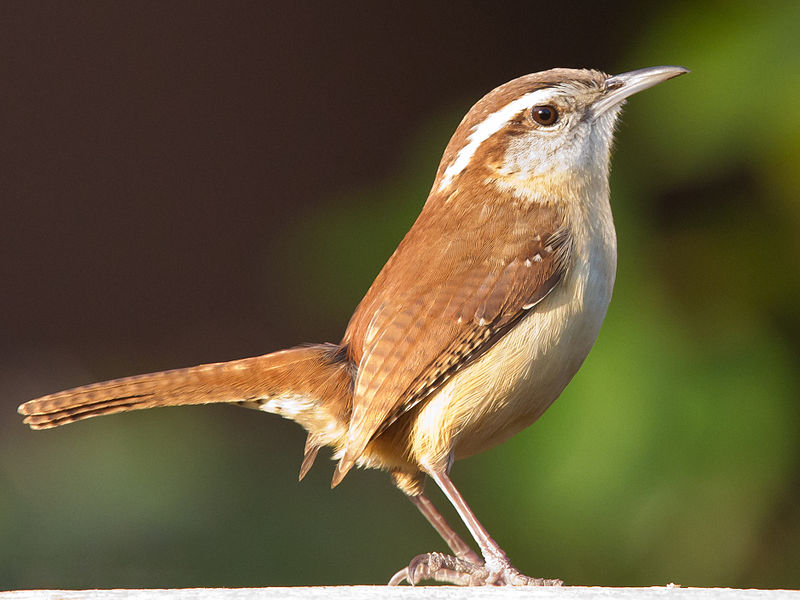
The Carolina wren (Thryothorus ludovicianus) is a medium-sized bird in the eastern United States, southern Ontario, and northeast Mexico.
They typically live in dense shrubbery or thickets near open areas such as gardens, parks, and woodland edges.
These birds are adaptable in nesting sites – they will build their nests anywhere from tree cavities to artificial boxes.
Their diet consists of insects, spiders, and other invertebrates, which they forage for on the ground or among vegetation.
The males have an unmistakable song of loud whistles interspersed with trills reminiscent of laughter; you’ll often find these cheerful little birds singing away during the early morning hours.
Scientific classification:
| Kingdom | Animalia |
| Phylum | Chordata |
| Class | Aves |
| Order | Passeriformes |
| Family | Troglodytidae |
| Genus | Thryothorus Vieillot, 1816[2] |
| Species | T. ludovicianus |
Also Featured In: Birds that Can be Seen in Outer Banks, Small Birds Live in Vermont
22. Barred Owl
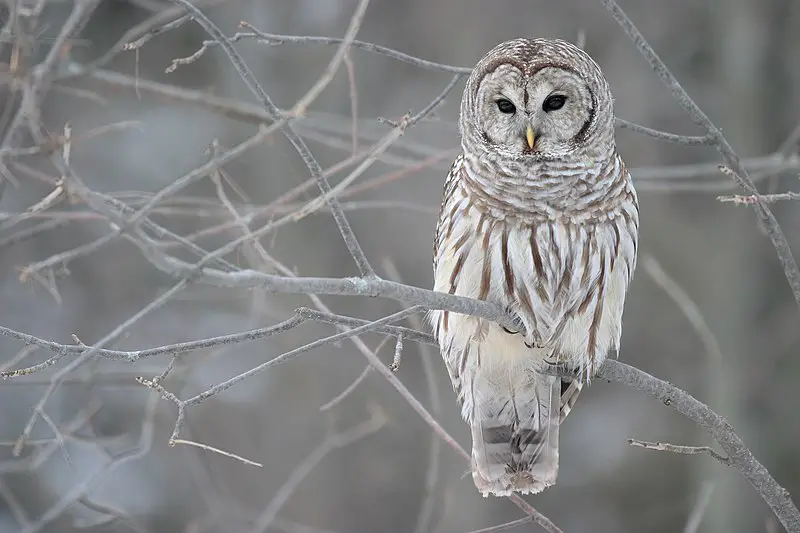
The Barred Owl is a large species of owl native to eastern North America. It belongs to the genus Strix, which is part of the true owl family Strigidae.
These beautiful birds are mainly brown with distinct stripes on their bodies and wings. Its face has dark eyes, a white chin patch, and two black bars across its yellow-brownish beak, giving it an intimidating appearance.
The barred owls have powerful nails for hunting small mammals like mice and voles and other animals such as fish, amphibians, or insects.
They also rely heavily on hearing when looking for prey in low-light conditions.
With their fantastic camouflage abilities, these birds can often remain undetected while observing potential threats from predators – making them highly successful hunters.
Scientific classification:
| Kingdom | Animalia |
| Phylum | Chordata |
| Class | Aves |
| Order | Strigiformes |
| Family | Strigidae |
| Genus | Strix |
| Species | S. varia |
Also Featured In: Most Popular Bird Species in North America, Birds You’ll Find in Zoo
23. Gray Catbird
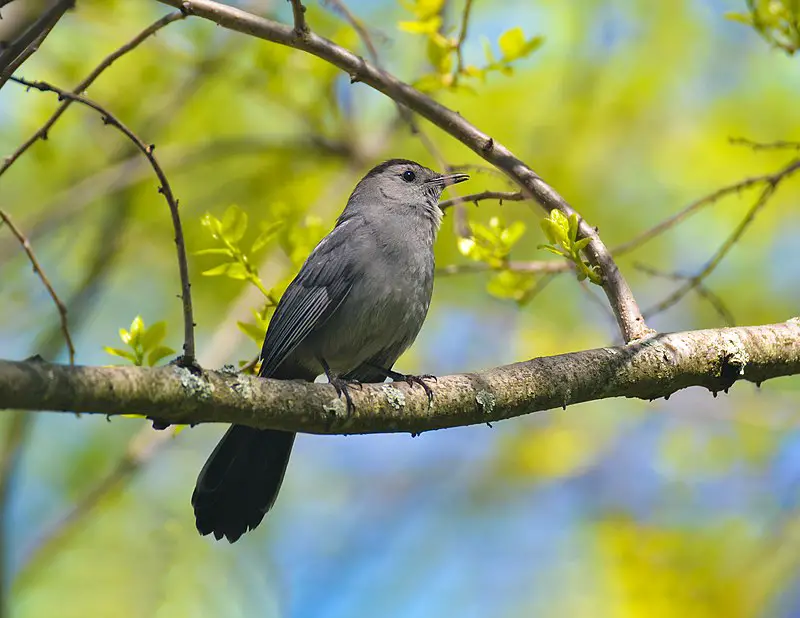
The Gray Catbird is a medium-sized bird native to North and Central America. It is the only species in its genus, Dumetella, which makes it unique among other perching birds of the Mimidae family.
Its plumage features shades of gray with some brownish tones on top and lighter grey below.
The underside of its tail has white feathers contrasting against their otherwise monochromatic coloration; this feature gives it its name as it often flicks its tail when alarmed or excited as cats do.
They are omnivorous but feed on insects such as caterpillars, grasshoppers, and beetles while eating fruits like berries or cherries during the summer.
Despite being commonly seen alone or in pairs, these birds often flock together for protection from predators like hawks. They are drawn to their dark coloration against green foliage, making them harder to spot.
Scientific classification:
| Kingdom | Animalia |
| Phylum | Chordata |
| Class | Aves |
| Order | Passeriformes |
| Family | Mimidae |
| Genus | Dumetella C.T. Wood, 1837 |
| Species | D. carolinensis |
Also Featured In: Gray Birds that You’ll Find in Minnesota, Birds that Live in Manitoba
24. Passerine
Passerines are a vast order of birds, comprising more than half the species. Many familiar garden and woodland species, such as sparrows, blackbirds, finches, and warblers, fall into this category.
Their arrangrecognizedoes can recognize them; three, pointing forward with one back, which helps them perch on branches or wires.
Passerines range from tiny wrens to large crows and have adapted to inhabit many environments worldwide, including forests, mountainsides, and deserts.
They feed mainly on insects, but some consume fruit and seeds depending on their diet preferences.
Their diversity is remarkable, from vibrantly colored tropical parrots to drab winter thrushes – making passerine birds an integral part of our natural heritage.
Scientific classification:
| Kingdom | Animalia |
| Phylum | Chordata |
| Class | Aves |
| Clade | Psittacopasserae |
| Order | Passeriformes Linnaeus, 1758 |
Also Featured In: Egyptian Birds, Turkey Birds You Should Know
25. European Goldfinch
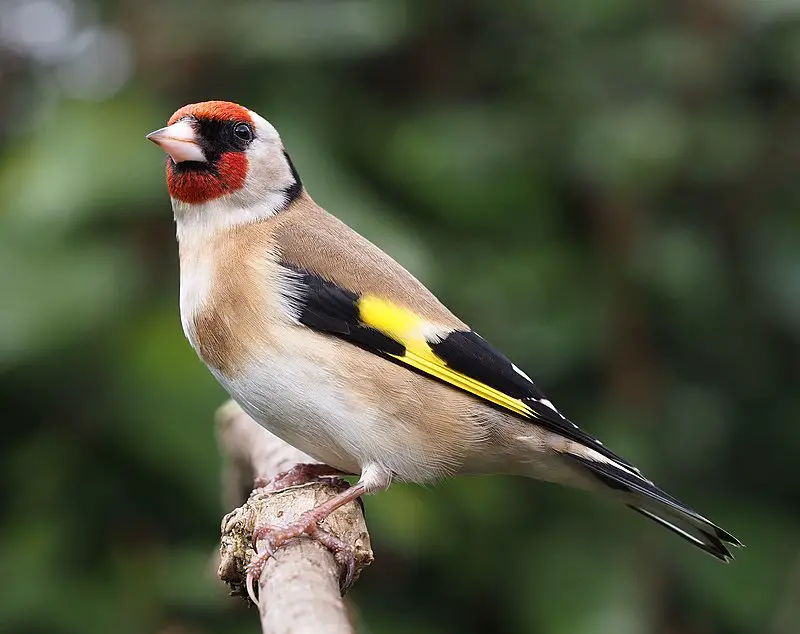
The European Goldfinch is a small passerine bird belonging to the finch family. It inhabits Europe, North Africa, and western and central Asia but has been introduced in other places such as Australia, New Zealand, and Uruguay.
Its red face can quickly identify the breeding male of this species, with black markings around the eyes and a black-and-white head.
Its back and flanks are buff or yellowish, while its white underparts contrast nicely with its dark wings, which are edged in white feathers.
This bird feeds on grains from plants like millet or sunflower seeds along with insects occasionally when available as a food source during summer.
In winter, they flock together near sources of water where they find their food among weeds growing there at that time of year.
Scientific classification:
| Kingdom | Animalia |
| Phylum | Chordata |
| Class | Aves |
| Order | Passeriformes |
| Family | Fringillidae |
| Subfamily | Carduelinae |
| Genus | Carduelis |
| Species | C. carduelis |
Also Featured In: Native Birds Of Germany, Common Birds of Portugal
26. Common Blackbird
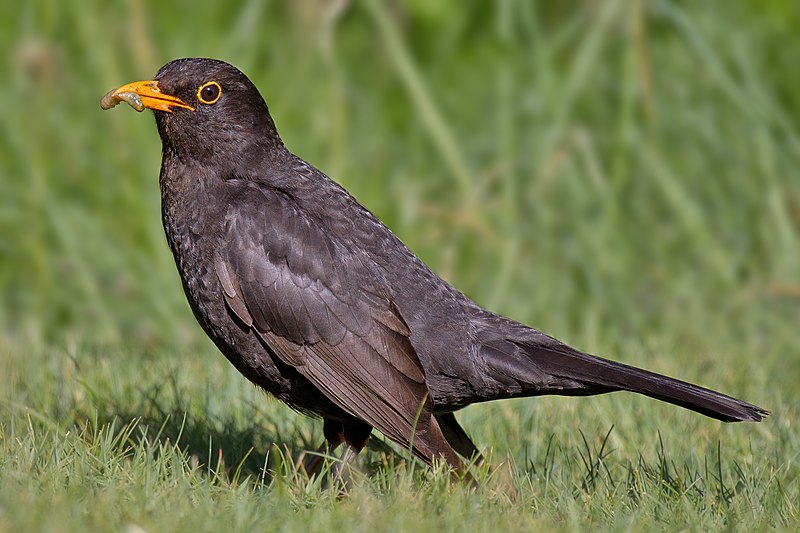
The Common Blackbird is a species of true thrush with the scientific name Turdus merula. Found in Europe, Asiatic Russia, and North Africa, it has also been introduced to Australia and New Zealand.
The male bird has glossy black plumage, while the female’s coloration is more brownish gray.
It is known for its melodious song that can be heard throughout the year; typically, they are seen alone or in pairs but occasionally form large flocks when food sources become available or during migration periods.
Its diet consists mainly of insects, worms, berries, and other fruits and some human-provided foods such as bread crumbs or garbage scraps when available.
With its wide distribution range and ease of adaptation to different habitats, this species will likely remain among our most common birds.
Scientific classification:
| Kingdom | Animalia |
| Phylum | Chordata |
| Class | Aves |
| Order | Passeriformes |
| Family | Turdidae |
| Genus | Turdus |
| Species | T. merula |
Also Featured In: Birds of United Kingdom, Most Common Spain Birds
27. Common Chaffinch

The Common Chaffinch is a beautifully colored small passerine bird from the finch family.
The males have striking blue-grey caps and rust-red underparts, while the females are more subtle in their coloring, but both possess two distinct white wing bars and white sides on their tails.
This gorgeous bird has a powerful voice that can be heard for miles as it sings from exposed perches during mating season.
It lives mainly throughout Europe and parts of North Africa and Asia, favoring woodland areas with plenty of shrubs or trees nearby where they find shelter amongst foliage when needed.
They feed predominantly on seeds from weeds or grains found within grasslands, making them beneficial birds for farmers who rely heavily upon the pest control that these little ones provide.
Scientific classification:
| Kingdom | Animalia |
| Phylum | Chordata |
| Class | Aves |
| Order | Passeriformes |
| Family | Fringillidae |
| Subfamily | Fringillinae |
| Genus | Fringilla |
| Species | F. coelebs |
Also Featured In: Red European Birds,
28. Common Chiffchaff
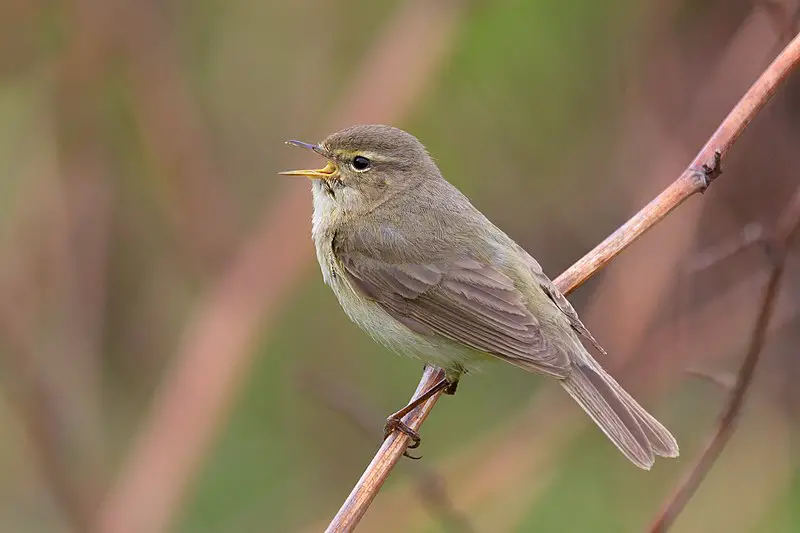
The Common Chiffchaff is a small bird found in northern and temperate Europe and the Palearctic.
It has greenish-brown plumage on its upper parts and off-white feathers beneath. It gets its name from an onomatopoeic call that resembles “chiff chaff.”
This migratory passerine breeds in open woodlands during summer before heading to southern Asia, western Europe, and North Africa for winter.
A frequent visitor at gardens with good insect supplies, it feeds mainly on insects such as flies, beetles, or ants caught by gleaning foliage or hawking aerial prey.
Despite being one of Britain’s most common birds – estimated numbers between 6–9 million pairs – their population numbers have declined over recent years due to habitat destruction caused by climate change.
Scientific classification:
| Kingdom | Animalia |
| Phylum | Chordata |
| Class | Aves |
| Order | Passeriformes |
| Family | Phylloscopidae |
| Genus | Phylloscopus |
| Species | P. collybita |
Also Featured In: Gujarati Birds, Birds that Can be Seen in October
Conclusion
Incorporating birds into song lyrics has been a timeless and versatile theme across various musical genres.
From iconic classics like The Beatles’ “Blackbird” to contemporary hits such as Sia’s “Bird Set Free,” birds symbolize freedom, resilience, and beauty in the human experience.
Through these 28 songs, we appreciate the enduring inspiration that birds provide to musicians, offering a musical reflection of nature’s influence on our creative expressions.